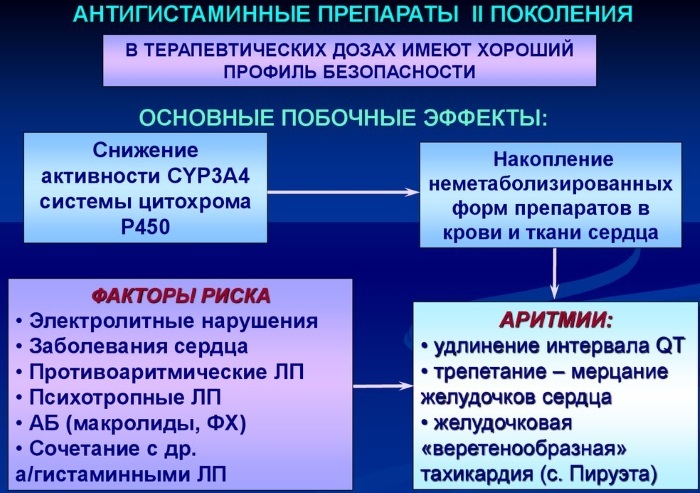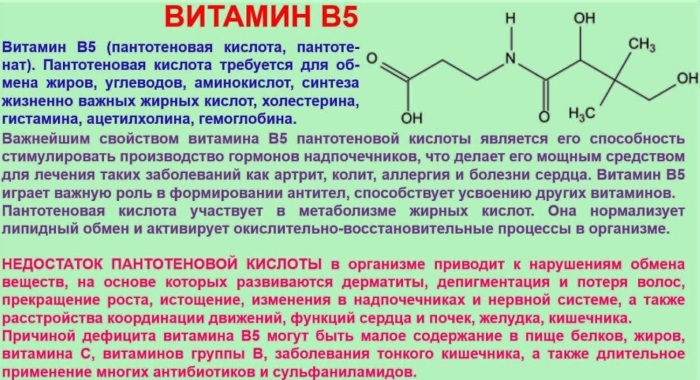The appearance or aggravation of allergic symptoms is a fairly common problem that occurs in 70% of women who have recently given birth. Severe stress to the body caused by the birth process, chronic lack of sleep and severe dehydration, arising during lactation, provoke the active production of histamine, which is responsible for the development of symptoms allergies.
The use of antihistamines compatible with breastfeeding helps to quickly stop inflammation and normalize the woman's condition, and low absorption and the practical absence of a sedative effect allows not to harm the central nervous system and the work of the adrenal glands of the thoracic baby.
Record content:
- 1 Causes of allergies in nursing mothers
- 2 Types of antihistamines and compatibility with lactation
- 3 Can I breastfeed with allergies?
- 4 What drugs are acceptable for hepatitis B?
-
5 How and what can be treated for allergies during lactation
-
5.1 First generation drugs
- 5.1.1 Suprastin
- 5.1.2 Tavigil
- 5.1.3 Hifenadine
- 5.1.4 Diphenhydramine
-
5.2 Second generation drugs
- 5.2.1 Laratadin (Claritin, Lominal)
- 5.2.2 Zyrtek (Tsetrin, Zodak, Ksizal)
- 5.2.3 Ebastin
- 5.2.4 Alcedeen
-
5.3 Third generation drugs
- 5.3.1 Levocetirizine
- 5.3.2 Allerfex
- 5.3.3 Erius (Deslortadin)
-
5.1 First generation drugs
- 6 Diazolin while breastfeeding
- 7 Unwanted drugs
- 8 Video about antihistamines
Causes of allergies in nursing mothers
After pregnancy and childbirth, a woman's body is in a state of immunodeficiency, which occurs against the background of high blood loss, lack of vitamins and minerals, chronic depression and lack of sleep.
A poor immune system becomes a sign of histamine release, accompanying the appearance of allergic reactions proceeding in the form of:
- hives;
- eczema;

- Quincke's edema;
- hay fever;
- false croup;
- bronchial asthma;
- anaphylactic shock.
Breastfeeding enhances the active production of histamine, which triggers allergic processes in the body of a young mother. An additional burden is also carried by severe dehydration of the body, which occurs against the background of an increase in calcium content, provoked by the lactation process.
Taking antihistamines prevents the production of histamine, and at the same time activates the coagulation of the previously secreted hormone in the plasma.
Types of antihistamines and compatibility with lactation
Antihistamines prevent the increased release of histamine, and also help its more rapid clotting in the blood plasma. Modern pharmaceutical companies offer several types of medicines to relieve allergic symptoms:
| 1st generation drugs | The good therapeutic activity of medicines is accompanied by the appearance of a strong sedative effect and a violation of the heart rate. |
|
| 2nd generation drugs | Effective for the treatment of all types of allergic reactions. They are approved for long-term use and do not have a pronounced hypnotic effect. |
|
| 3rd generation drugs | They are characterized by increased antihistamine activity and a low risk of side effects. |
|

Treatment of allergy symptoms during breastfeeding is carried out only with medicines related to to the 2nd and 3rd generation, which is characterized by high efficiency and a low percentage of the appearance of side effects.
The use of any drugs during lactation must be agreed with your doctor. He also selects the optimal treatment regimen, and, if necessary, uses immune replacement therapy.
Can I breastfeed with allergies?
Antihistamines for breastfeeding should be taken at the first symptoms of allergy. Unpleasant skin, intestinal or respiratory signs of allergy that bother a young mother are completely harmless to the newborn and are not transmitted with breast milk.
A woman suffering from allergies before pregnancy is able to pass the allergenic gene to her baby, but breastfeeding feeding contributes to a significant increase in the immunity of the baby and the prevention of active production in his body histamine.
Having a predisposition to frequent exacerbations of allergic symptoms, the expectant mother should stock up on safe for the baby with antihistamines, and then take them throughout pregnancy and breastfeeding feeding.
In addition to the regular use of antihistamines, it is recommended to exclude the possible influence of allergens, including:
- household allergens surrounding a woman (pet hair, mold, household chemicals, perfume water);
- foodborne food allergens such as cocoa, tangerines, shrimp, nuts and eggs;
- drug allergens;
- biological allergens, accompanied by an attack by pathogenic microorganisms;
- physical allergens (high or very low air temperatures).
What drugs are acceptable for hepatitis B?
Antihistamines during breastfeeding are allowed to be drunk only under the strict supervision of a doctor who selects safe for a newborn drug and its dosage depending on the individual characteristics of the young mom.
The safest for the health of a young mother and her nursing baby are medicinal antihistamines of the 2nd and 3rd generation.

Tablets that do not provoke the appearance of drowsiness and do not change the heart rate, according to the results of a study by Spanish and British specialists, enter breast milk in small quantities, as a result of which they do not have a serious negative effect on the central nervous system and do not harm newborn baby.
The safest for breastfeeding mothers are medications sold in the form of a solution for inhalation or a spray. These drugs have a local effect and do not pass into breast milk.
The pills used to treat allergic symptoms back in the days of the Soviet Union are prohibited during lactation as outdated medicinal products, with a short pharmaceutical effect and a high likelihood of side effects effects.
How and what can be treated for allergies during lactation
Antihistamines are prescribed to stop the active production of histamine, which can quickly relieve the severity of unpleasant allergy symptoms.
First generation drugs
1st generation drugs help to effectively fight allergies, but at the same time are highly sedative. activity, the ability to change the heart rate and increase hypertension, and are also able to provoke problems from the outside Gastrointestinal tract and central nervous system.
Suprastin
An antihistamine drug based on chlorapamine hydrochloride has a blocking effect on histamine receptors, suspending their activity for a period of 3 to 6 hours. Conducting a moderate antiemetic and antispasmodic effect, the drug has a strong sedative effect, provoking drowsiness, distraction and headache.
Effective against all types of allergic reactions, Suprastin is prohibited during breastfeeding due to its the ability to change the heart rate, provoke instability of the nervous system and gastrointestinal disorders of both the mother and her newborn baby.
If treatment with Suprastin is necessary, lactation should be suspended for the entire period of taking the drug.
Tavigil
A drug based on clemastine hydrogen fumarate, which has a strong antihistamine and antipruritic effect.
Providing antiallergic effect that lasts up to 12 hours Tavigil:
- reduces vascular permeability;
- inhibits the formation of edema;
- reduces itching;
- prevents muscle contraction that occurs under the influence of histamine.
The drug provoking the development of increased drowsiness and lethargy, both in the mother and in the newborn baby, is prohibited during breastfeeding. In the case of taking Tavigil, a lactating woman must strictly monitor the condition of the child. (especially during sleep) and be prepared for the newborn's crying and rejection food.
Hifenadine
A 1st generation antihistamine that blocks the action of receptors that increase the amount of histamine that has entered the bloodstream. Providing a low local anesthetic effect, Hifenadine reduces the negative effect of histamine on the vessels and organs of the gastrointestinal tract.
Possessing an efficacy lasting up to 8 hours, the drug is prohibited for use throughout pregnancy and lactation due to its high sedative activity and provoking the appearance of dry mucous membranes in a young mother and her child.
Diphenhydramine
A drug that blocks histamine receptors has antiallergic, anesthetic, antispasmodic and antiemetic activity. The solution, which quickly penetrates into the central nervous system of the mother, dulls the activity of serotonin receptors, exerting a strong suppressing nervous activity and hypnotic effect.
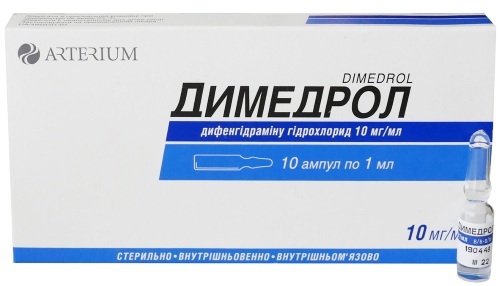
Widely used for allergic rhinitis and conjunctivitis, itchy dermatosis, eczema and Quincke's edema, the drug is undesirable for use during the period breastfeeding because of its ability to provoke severe sedative disorders that occur in both the breastfeeding mother and her baby.
Second generation drugs
Antihistamines of the 2nd generation are most often prescribed for breastfeeding, since they have the least number of side effects and practically do not pass into breast milk.
Laratadin (Claritin, Lominal)
The drug, which has antiallergic and antipruritic effects, is capable of blocking the activity of histamine receptors for a long time. The active substance of the drug prevents and eases the course of allergic reactions, relieves swelling, spasms smooth muscles, while not exerting a pronounced sedative effect, without affecting the central nervous system and without causing addictive.
A low potential for the appearance of side symptoms and a low concentration in breast milk makes it possible the use of drugs containing loratadine throughout the entire lactation period is strictly under the supervision of a physician and in the selection of an individual dosage.
Zyrtek (Tsetrin, Zodak, Ksizal)
The drug containing cetirizine dihydrochloride quickly blocks histamine receptors, preventing the development and facilitating the course of allergic reactions.
Possessing antipruritic and antiexudative qualities, the drug affects the early stage of histamine production, eliminates skin the reaction arising from irritation with specific allergens (heat, cold), relieves swelling and facilitates the course of bronchial asthma.
The drug, approved from an early age, acts for 24 hours, does not penetrate into breast milk, does not have any negative effect on the child, and does not suppress the central nervous system.
Ebastin
The blocker of histamine receptors has a long-term antiallergic effect (lasting up to 48 hours), accompanied by the formation of active metabolites. The drug, which does not enter the central nervous system and breast milk, does not have a pronounced sedative effect and is approved for use during the lactation period.
Alcedeen
Antiallergenic spray containing beclomethasone dipropionate is highly anti-inflammatory, antipruritic and immunosuppressive action, which helps to reduce swelling and secretion of the mucous membrane of the respiratory tract, thereby improving penetration oxygen.
The spray, which has a local therapeutic effect, does not penetrate into breast milk, thus, completely without affecting the activity of the adrenal cortex of the newborn, and also has no pronounced sedative qualities.
Third generation drugs
Antihistamines of the 3rd generation are considered the most advanced drugs used to treat allergies, whose action is associated with the formation of active metabolites.
Not having a sleeping pill effect and not changing the heart rate, these drugs are approved for use in all during the lactation period, since they almost do not affect the work of the central nervous system and the functioning of the adrenal glands of the thoracic child.
Levocetirizine
Antiallergic drug that selectively affects the activity of histamine receptors. Penetrating into the body, highly effective Levocetirizine inhibits the development of allergic reactions, without exerting a pronounced serotonin effect.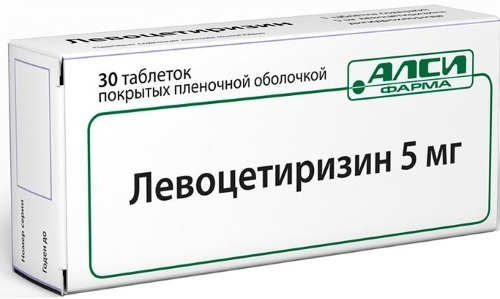
Actively coping with the symptoms of seasonal rhinitis, urticaria, hay fever, the drug normalizes the woman's condition, and also actively fights skin reactions to specific allergens.
The use of Levocetirizine during lactation is conditionally allowed, since it does not penetrate into breast milk the drug does not have a negative effect on the child and does not provoke inhibition of the central nervous system in his mom.
Allerfex
Tablets containing 30 ml of fexofenadine block histamine receptors for up to 48 hours without causing sedation. Used in the symptomatic treatment of allergic rhinitis and urticaria, Allerfex enters a small amount in breast milk, while almost does not affect the condition and activity newborn.
Erius (Deslortadin)
Blocking histamine receptors and suppressing chain inflammatory processes, the drug is indicated for the symptomatic treatment of seasonal or perennial rhinitis and chronic urticaria.
Excreted in small amounts with breast milk, the drug does not affect the serotonin connections of the central nervous system of a young mother and her baby, and also does not inhibit the activity of the child's adrenal glands.
Diazolin while breastfeeding
Antihistamines during breastfeeding can be taken no more than 1 time a day, which minimizes the ingestion of active substances of drugs into breast milk.

Popular in the Soviet Union and included in the drugs that suspend the allergic symptoms of fever Diazolin belongs to the 1st generation antihistamines undesirable for use during pregnancy and lactation.
High efficiency that lasts up to 2 days and low toxicity of the drug created based on mebhydroline, made it quite popular, but not compatible with breastfeeding drug. Penetrating easily through the hemolactic barrier, Diazolin is excreted along with breast milk, getting into the body of a newborn baby and provoking the appearance of:
- irritation of the stomach lining, causing diarrhea, nausea, abdominal cramps and stool disturbances;
- drowsiness, lethargy, blurred vision;
- dry mouth;
- problems with urination;
- increased irritability;
- insomnia;
- trembling knees.
The use of Diazolin during the lactation period should be carried out only by the decision of the doctor and strictly after the completion of breastfeeding.
Unwanted drugs
Medicines for breastfeeding are selected only by a specialist who strictly sets their dosage. It is not allowed to use during lactation drugs related to 1st generation antihistamines or previously used in the Soviet Union, including:
| Suprastin | It has a strong sedative effect, which has a negative effect on the central nervous system of a young mother and a newborn. |
| Diazolin | In large quantities, it penetrates into breast milk, provoking the appearance of increased nervousness, tremors in the knees and sleep disturbance in an infant. |
| Diphenhydramine | The drug, which has strong sedative qualities, is excreted together with breast milk, causing sleep disturbance and stupor in the newborn. |
| Tavegil and Clemastine |
|
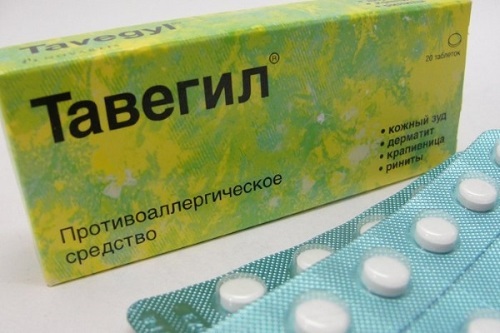
In addition to drugs, to prevent the appearance and development of allergic reactions, a young mother should:
- limit contact with furry pets;
- less walking along the streets during the flowering period of plants;
- ventilate the room daily and carry out wet cleaning;
- periodically clean dust from pillows, blankets, carpets and curtains;
- subject the soft toys in the house to high temperatures;
- exclude possible allergens from the diet (chocolate, nuts, red vegetables and fruits, citrus fruits);
- use household chemicals in limited quantities;
- give up perfumes and cosmetics that have a pronounced aroma.
While breastfeeding, a young mother should follow a gentle, low-carb diet that includes plenty of fluids. and low-allergenic products that prevent a sharp release of histamine into the body, which provokes the appearance of allergic reactions.
Together with the intake of antihistamines, the doctor prescribes a course of Polysorb or Enterosgel for a nursing mother, which helps cleanse the body of toxins and reduce the negative effect of histamine.
The occurrence of allergies in a woman breastfeeding can be triggered by specific allergens or high the body's production of histamine, which is activated by stress, chronic fatigue and high daily loss liquids.
Allergy treatment is carried out at home and requires immediate administration of 2nd and 3rd generation antihistamines. According to research by Spanish and British scientists, such drugs have a low level of sedation. effect, practically do not get into breast milk and do not cause negative reactions in a newborn baby.
Video about antihistamines
Doctor about antihistamines:

